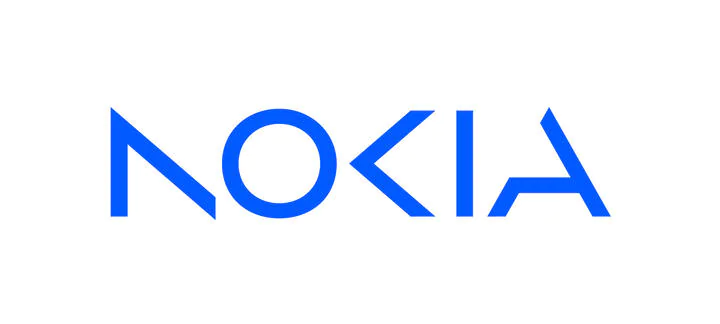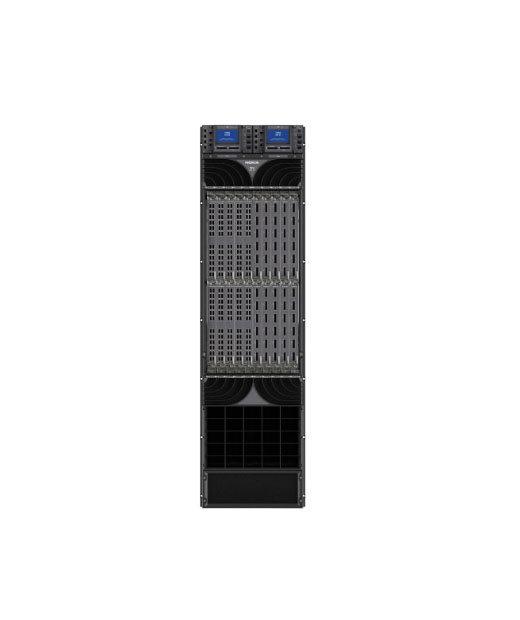Nokia 7950 XRS-20
Extensible Routing System
The Nokia 7950 XRS-20 provides up to 32 Tb/s full duplex switching capacity in a single 19-in rack. Each XRS-20 system offers 20 slots, each capable of 1600 Gb/s full duplex aggregate interface capacity. Fully equipped with FP4 hardware, it offers up to 320 100GE, 80 400GE or 3200 10GE ports in a single rack. The 7950 XRS-20 supports a mix of FP4 and FP3-based XCMs and XMAs in the same chassis by exchanging the SFM cards for FP4 variants. All other hardware components including CPM, CCM, fans and APEQs can be reused to maximize investment protection.
Nokia 7950 XRS Extensible Routing System Product Family
The 7950 XRS family is designed to meet the needs of global, national, regional and private network operators of all sizes. The common platform addresses the full spectrum of networking needs for public and private internet backbones and peering points, metropolitan and regional aggregation hubs as well as cloud, data center and mobile core infrastructure. This will enable network operators to deliver the immersive ultra-broadband service experiences that consumers aspire to today and will expect tomorrow.
One platform for all services
The 7950 XRS addresses the full range of core routing requirements using common hardware that runs the proven, resilient and feature-rich Service Router Operating System (SR OS). A flexible, pay-as-you-go software licensing model allows you to build a versatile, reliable and converged core network that evolves with your needs while protecting your hardware investments.
Performance at scale, powered by FP4
A modular and extensible hardware design powered by Nokia FP4 routing silicon ensures granular and economical scaling of switching capacity and port density with deterministic forwarding performance. A single 7950 XRS-20e chassis equipped with FP4 hardware delivers up to 48 Tb/s full duplex switching capacity, and supports port densities of up to 160 400GE, 800 100GE or 4800 10GE interface ports, with flexible 10GE, 40GE, 100GE and 400GE breakout options provided by universal QSFPDD or QSFP28 ports. Equipped with six-port CFP2-DCO XRS Media Adapters (XMAs), a single chassis supports up to 240 100G clear channel interfaces with optics. A single 7950 XRS-20 chassis equipped with FP4 hardware delivers 32 Tb/s full duplex switching capacity, and supports up to 80 400GE, 320 100GE or 3200 10GE interface ports. See table 3 for more scaling details.
400G IP-optical integration
The Nokia 7950 XRS is ready for the 400GE era. The FP4-based QSFP56-DD and CFP2-DCO XMAs support 400G ZR and ZR+ coherent pluggable router optics at scale for high-capacity data center interconnect, metro and regional core network applications. A standards-based GMPLS user-network interface (UNI) enables IP-optical control plane integration, allowing the 7950 XRS to efficiently coordinate IP routing and transport requirements across administrative boundaries and to dynamically set up optical segments and end-to-end transport connections.
Cross-domain management
The 7950 XRS is managed by the Nokia Network Services Platform (NSP), supporting integrated element and network management with end-to-end orchestration of network resource provisioning and assurance operations.
Carrier SDN integration and automation
The 7950 XRS and SR OS enable multivendor software-defined networking (SDN) control integration through OpenFlow, Path Computation Element Communication Protocol (PCEP) and model-driven network element management through CLI, NETCONF and gRPC/gNMI using YANG models. Network operators can leverage the 7950 XRS in combination with the NSP to introduce scalable and integrated carrier SDN control across IP, MPLS, Ethernet and optical transport layers. The NSP supports unified service automation and network optimization with comprehensive path computation capabilities to enable sourcebased routing and traffic steering with segment routing support, online traffic engineering and resource optimization, and elastic bandwidth services for dynamic cloud applications. The NSP is further assisted by Deepfield analytics to support insight-driven automation of network and flow optimization, as well as DDoS attack mitigation.
Features & Benefits
-
The 7950 XRS leverages Nokia’s industry-leading FP4 NPU routing silicon to ensure optimal performance and scaling of a rich and complete Layer 2 and Layer 3 feature set that addresses all core deployment scenarios. The 3 Tb/s FP4 chipset is Nokia’s fourth-generation NPU and provides the perfect geometry for high-density 100G and 400G interface modules, with support for 1 Terabit Ethernet (TE) line rates. It offers deterministic forwarding performance with enhanced packet intelligence and control capabilities for advanced traffic management and granular DDoS filtering policies.
These silicon innovations drive the high level of flexibility and performance needed for converged backbone and metro core deployments,including IP routing and peering, MPLS switching, VPN infrastructure services and data center interconnection applications.
Modular hardware architecture
The Nokia 7950 XRS has a modular and scalable hardware architecture with universal linecards to enable cost-efficient pay-as-you-grow system evolution with optimal investment protection. Line card licenses add flexibility for tailoring and tuning 7950 XRS systems to customers’ evolving needs. Capability-level licenses provide growth options on the number of connectors, total connector bandwidth and intelligent fan-in/fanout aggregation mode (see Table 2 for details).
Functional-level licenses provide growth options to scale services and unlock the full array of IP routing features, functions and applications with advanced QoS capabilities through a simple license upgrade, without hardware changes or maintenance windows. This enables operators to consolidate core routing systems on a single platform, and to rapidly respond to evolving requirements with minimal impact and maximum investment protection.
Operating system
The 7950 XRS family is based on the proven SR OS, carrying forward over a decade of experience in the IP networks of more than 750 network operators worldwide. With a single common OS across the Nokia routing portfolio, network operators benefit from an extensive track record of reliability in the field and a full suite of features to enable resiliency, high availability and in-service software upgrade (ISSU).
Power and cooling efficiency
The 7950 XRS system design incorporates intelligent power management capabilities to monitor power consumption of individual components, assure power safety thresholds, and manage power-up and power-down priorities in the event of degraded power availability. Other key enhancements include clock gating techniques that dynamically reduce power to system components not in use. Redundant, modular fan trays that are linearly modulated provide appropriate and efficient cooling with reduced noise levels. A “pull” airflow design, in combination with impedance panels and air guides, ensures an even distribution of air to every section of the system. Hot air exhaust through the back of the chassis ensures a clean separation between the hot and cold aisles. An optional top plenum accessory is available for the 7950 XRS-20 to enable hot air exhaust at the top of the chassis for additional cooling efficiency.
Routing silicon







